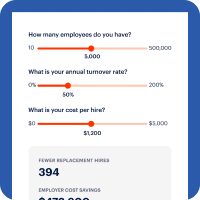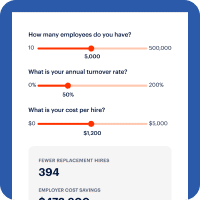In recent years, the concept of on-demand pay, often referred to as earned wage access, has gained significant attention in the private sector. With on-demand pay, employees can access their earned pay before their employer scheduled paydays. The flexibility provides them with greater financial control that enables them to make different decisions and avoid the expensive alternatives they’re using today.
While on-demand pay has primarily been a benefit offered to employees of private companies, there is increasing interest in extending this benefit to state, county and city government workers across all public sectors, including K-12 education.
In this blog post, we’ll explore why offering on-demand pay for government workers is a valuable addition to government agency benefits programs due to its potential for improving the lives of public employees and its ability to help state, county and city governments attract and retain a workforce for the next generation of public service.
Improved Employees’ Financial Stability
One of the primary benefits of on-demand pay is that it can improve financial stability for employees. Government workers, like many other employees, often face unexpected expenses or emergencies that require immediate financial assistance. In these situations, on-demand pay can be a lifeline, allowing employees to access their earned pay before their regular payday.
For example, a government employee who needs to repair their car to get to work may not have the funds available to cover the cost until their next paycheck. With on-demand pay, they could access a portion of their earned pay to cover the expense, rather than turning to high-cost loans or credit cards.
Additionally, with visibility to their earnings, workers can better plan their finances. They can calculate their potential earnings and take on more shifts or work extra hours to ensure sufficient funds are available in their next paycheck.
By offering on-demand pay, state, county and city governments can help their employees achieve greater financial stability, reduce their reliance on high-cost borrowing options and improve their overall financial wellness.
Results from the private sector demonstrate the significant impact on-demand pay can have on employee financial wellness. In a November 2022 survey of DailyPay users, 49% indicated DailyPay helps them avoid late fees or overdraft fees and 47% indicated DailyPay has helped them avoid taking out a payday loan.1
Reduced Financial Stress and Anxiety
Financial stress is a common problem for many workers, including those employed by state, county and city governments. According to recent Harris Poll research commissioned by BPC’s Funding our Future Coalition and DailyPay, more than 3 in 5 working Americans feel anxious about their current financial situation.
Offering on-demand pay can help reduce this stress and anxiety by providing workers with greater financial flexibility. By having the ability to access their earned pay when they need it, employees can better manage unexpected expenses, reduce the need for high-cost borrowing options and improve their overall financial well-being. For example, in a November 2022 DailyPay user study, 67% indicated DailyPay has helped them reduce financial stress.2
This enhanced financial control can have a positive impact on employee productivity and job satisfaction, as workers who are less stressed and anxious are more likely to be engaged and focused on their work.
Increased Transparency and Accountability
Finally, offering on-demand pay can help increase transparency and accountability in government agencies. By providing workers with real-time access to their earned wages, agencies can demonstrate their commitment to fairness and equity. For example, as awareness of the benefits of on-demand pay become more well-known, workers across all age groups are recognizing its importance. An ADP Earned Wage Access Market Research Study found that 76% of workers across all age groups say it is important for their employer to offer earned wage access.
Improved Retention and Recruitment
State, county and city governments face stiff competition when it comes to attracting and retaining top talent. Offering on-demand pay can be a valuable tool in this effort, as it can help differentiate government agencies from private sector employers.
Yet, the sobering reality is that it’s not a quick, easy fix. The situation with K-12 school districts provides a good example. McKinsey points out in their March 2, 2023 article: “K–12 schools in the United States are finding it increasingly difficult to retain teachers, with potentially far-reaching ramifications for society. Over the past decade, the annual teacher turnover rate has hovered around 8% nationally and is more than double that for schools designated for Title 1 funding. By comparison, the annual turnover rate in high-performing jurisdictions, such as Finland, Ontario and Singapore, is approximately 3 to 4%.”
And the challenge doesn’t stop there. Although teacher shortages tend to receive most of the attention, a recent RAND report4 suggests the spotlight should also be shined on principals.
Anna Merod’s article in K-12 Dive states it well:
“The principal turnover findings are in line with other surveys, including one from the National Association of Secondary School Principals that showed over half of 1,000 school leaders were considering a career change or early retirement in 2022. Those principals cited staffing shortages and their own mental health as reasons they were looking to leave the profession.”
Actions from insights provided by these types of research and analysis need to focus on both retaining teachers and principals along with attracting new talent to the education profession.
Although it will take much more than on-demand pay to solve the challenges faced by school districts and local governments, by including it as part of their benefit offering, government employers can demonstrate that they value their employees and are committed to supporting their financial well-being. This approach can help improve employee retention rates, as workers who feel valued and supported are more likely to stay with their current employer. In fact, in a November DailyPay user study, 52% indicated their opinion of their employer has improved since they began using DailyPay.3
Address Challenges With Earned Wage Access
State, county and city governments are facing significant competition for talent from the private industry. This challenge is being exacerbated by the forthcoming wave of retirements with nearly 50% of Baby Boomers employed by municipalities set to retire over the next five years.
To address these challenges, public sector leaders have an opportunity to adopt a new approach to wages and benefits as part of becoming more nimble and dynamic in their workforce practices to ensure adequately skilled staffing.
By doing so, they can not only fill the current gaps but also position themselves for success in the next generation of public service.
1 November 2022 DailyPay User Survey:DailyPay, 2020
2 November 2022 DailyPay User Survey:DailyPay, 2020
3 November 2022 DailyPay User Survey:DailyPay, 2020
4 RAND’s report is based on a survey conducted with 300 school district and charter school network leaders from October to December 2022.:DailyPay, 2020













